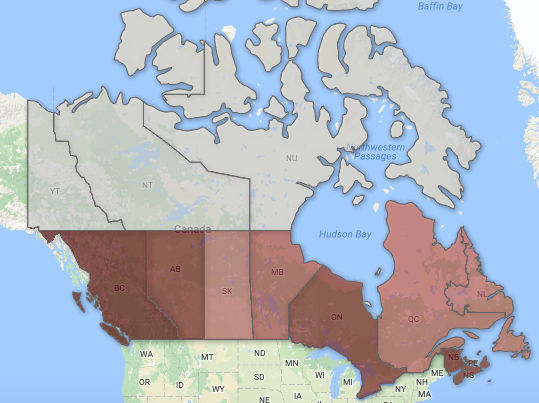
Science & Tech
20 Canadian innovations you should know about
Celebrating Canadian Innovation Week 2023 by spotlighting the people and organizations designing a better future
- 3327 words
- 14 minutes
This article is over 5 years old and may contain outdated information.
Mapping

Even though it’s sometimes used as an excuse to get out of social arrangements, food poisoning is no joking matter. According to the Conference Board of Canada’s 2016 food safety report card, there are four million cases of domestically acquired food-borne illnesses annually. On average, 240 people die from contaminated food and water every year.
The report documents incidents related to four bacteria-driven illnesses (Campylobacter, Salmonella, E. coli 0157 and Listeria) borne out of food and water in 2014. The data applies only to the provinces, as no information was reported for Yukon, the Northwest Territories or Nunavut. The territories were assigned a value of zero on the maps below to assist in visualization.
Some provinces fared better than others for certain illnesses. We’ve mapped out the results below, expressed in a rate of infection per 100,000 people.
* * *
Campylobacter, a bacteria that commonly occurs in animals, typically infects humans who have consumed undercooked meats and egg products or unpasteurized milk. This bacteria was recorded as the most prevalent cause of food-borne illness in the report. Campylobacter caused five deaths in 2014.
* * *
Salmonella is most commonly acquired from undercooked or lightly cooked poultry and egg products that have been infected by the bacteria. There were 17 recorded deaths from salmonella in Canada in 2014.
* * *
E. coli 0157 was the cause of the disaster that struck Walkerton, Ont., in 2000, during which seven residents died and more than 2,000 became ill from the bacteria. There were eight recorded deaths from this illness in Canada in 2014, with Prince Edward Island recording the highest number of incidents of the provinces.
* * *
Listeria, the deadliest of these four pathogens, ranked lowest in overall incidents but resulted in the most deaths. This bacteria is most commonly found in sewage, soil and untreated water, and refrigerated smoked fish and unpasteurized dairy products are among the foods of greatest risk. In 2014, 35 Canadians died from Listeria.
Are you passionate about Canadian geography?
You can support Canadian Geographic in 3 ways:

Science & Tech
Celebrating Canadian Innovation Week 2023 by spotlighting the people and organizations designing a better future

Wildlife
Canada jays thrive in the cold. The life’s work of one biologist gives us clues as to how they’ll fare in a hotter world.

Travel
The trail started with a vision to link Canada coast to coast to coast. Now fully connected, it’s charting an ambitious course for the future.

People & Culture
Here are a few of the ways community-led projects, government programs and other organizations are helping to feed northern populations